YAMAHA XT660Z 2015 Owner's Manual
Manufacturer: YAMAHA, Model Year: 2015, Model line: XT660Z, Model: YAMAHA XT660Z 2015Pages: 98, PDF Size: 8.44 MB
Page 21 of 98
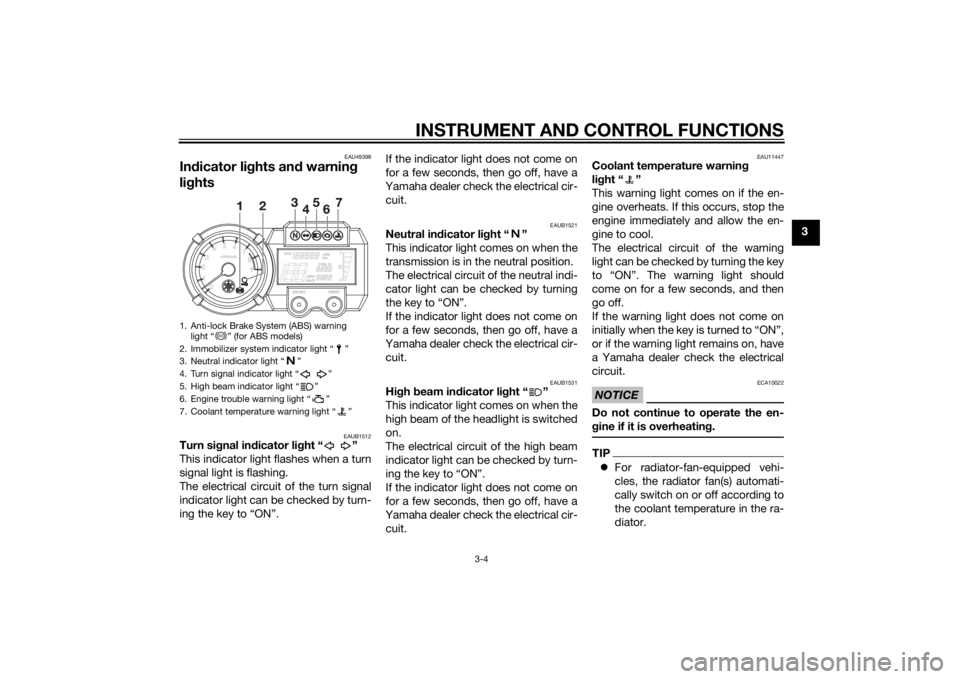
INSTRUMENT AND CONTROL FUNCTIONS
3-4
3
EAU49398
Indicator lights and warning
lights
EAUB1512
Turn signal indicator light “ ”
This indicator light flashes when a turn
signal light is flashing.
The electrical circuit of the turn signal
indicator light can be checked by turn-
ing the key to “ON”.If the indicator light does not come on
for a few seconds, then go off, have a
Yamaha dealer check the electrical cir-
cuit.
EAUB1521
Neutral indicator light “ ”
This indicator light comes on when the
transmission is in the neutral position.
The electrical circuit of the neutral indi-
cator light can be checked by turning
the key to “ON”.
If the indicator light does not come on
for a few seconds, then go off, have a
Yamaha dealer check the electrical cir-
cuit.
EAUB1531
High beam indicator light “ ”
This indicator light comes on when the
high beam of the headlight is switched
on.
The electrical circuit of the high beam
indicator light can be checked by turn-
ing the key to “ON”.
If the indicator light does not come on
for a few seconds, then go off, have a
Yamaha dealer check the electrical cir-
cuit.
EAU11447
Coolant temperature warning
light “ ”
This warning light comes on if the en-
gine overheats. If this occurs, stop the
engine immediately and allow the en-
gine to cool.
The electrical circuit of the warning
light can be checked by turning the key
to “ON”. The warning light should
come on for a few seconds, and then
go off.
If the warning light does not come on
initially when the key is turned to “ON”,
or if the warning light remains on, have
a Yamaha dealer check the electrical
circuit.NOTICE
ECA10022
Do not continue to operate the en-
gine if it is overheating.TIPFor radiator-fan-equipped vehi-
cles, the radiator fan(s) automati-
cally switch on or off according to
the coolant temperature in the ra-
diator.
1. Anti-lock Brake System (ABS) warning
light “ ” (for ABS models)
2. Immobilizer system indicator light “ ”
3. Neutral indicator light “ ”
4. Turn signal indicator light “ ”
5. High beam indicator light “ ”
6. Engine trouble warning light “ ”
7. Coolant temperature warning light “ ”
ABS
U2BDE1E0.book Page 4 Tuesday, December 16, 2014 5:38 PM
Page 22 of 98
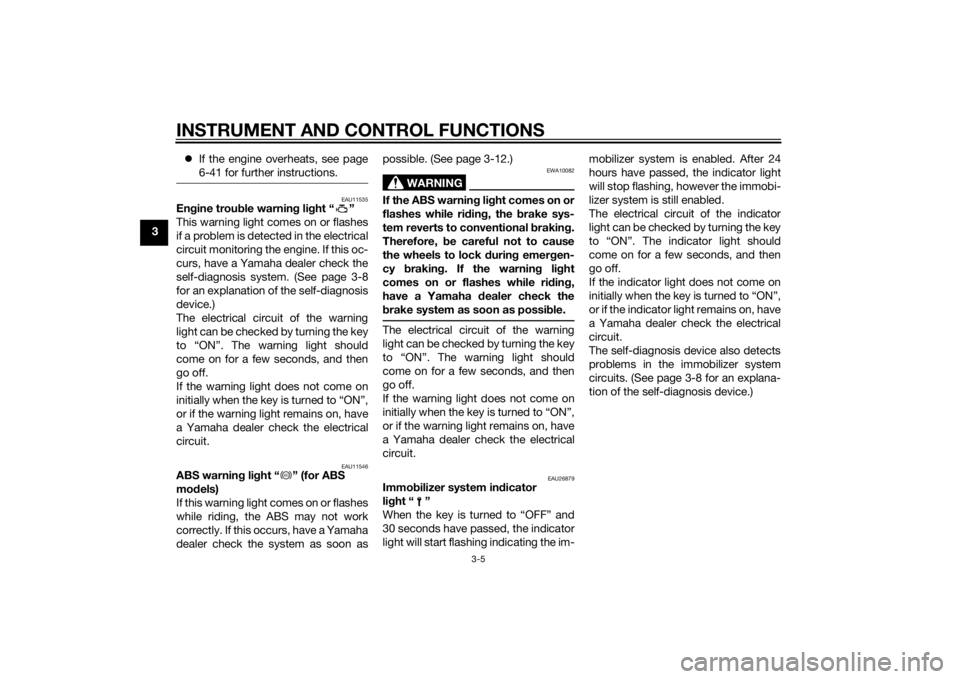
INSTRUMENT AND CONTROL FUNCTIONS
3-5
3If the engine overheats, see page
6-41 for further instructions.
EAU11535
Engine trouble warning light “ ”
This warning light comes on or flashes
if a problem is detected in the electrical
circuit monitoring the engine. If this oc-
curs, have a Yamaha dealer check the
self-diagnosis system. (See page 3-8
for an explanation of the self-diagnosis
device.)
The electrical circuit of the warning
light can be checked by turning the key
to “ON”. The warning light should
come on for a few seconds, and then
go off.
If the warning light does not come on
initially when the key is turned to “ON”,
or if the warning light remains on, have
a Yamaha dealer check the electrical
circuit.
EAU11546
ABS warning light “ ” (for ABS
models)
If this warning light comes on or flashes
while riding, the ABS may not work
correctly. If this occurs, have a Yamaha
dealer check the system as soon aspossible. (See page 3-12.)
WARNING
EWA10082
If the ABS warning light comes on or
flashes while riding, the brake sys-
tem reverts to conventional braking.
Therefore, be careful not to cause
the wheels to lock during emergen-
cy braking. If the warning light
comes on or flashes while riding,
have a Yamaha dealer check the
brake system as soon as possible.The electrical circuit of the warning
light can be checked by turning the key
to “ON”. The warning light should
come on for a few seconds, and then
go off.
If the warning light does not come on
initially when the key is turned to “ON”,
or if the warning light remains on, have
a Yamaha dealer check the electrical
circuit.
EAU26879
Immobilizer system indicator
light “ ”
When the key is turned to “OFF” and
30 seconds have passed, the indicator
light will start flashing indicating the im-mobilizer system is enabled. After 24
hours have passed, the indicator light
will stop flashing, however the immobi-
lizer system is still enabled.
The electrical circuit of the indicator
light can be checked by turning the key
to “ON”. The indicator light should
come on for a few seconds, and then
go off.
If the indicator light does not come on
initially when the key is turned to “ON”,
or if the indicator light remains on, have
a Yamaha dealer check the electrical
circuit.
The self-diagnosis device also detects
problems in the immobilizer system
circuits. (See page 3-8 for an explana-
tion of the self-diagnosis device.)
ABS
U2BDE1E0.book Page 5 Tuesday, December 16, 2014 5:38 PM
Page 23 of 98
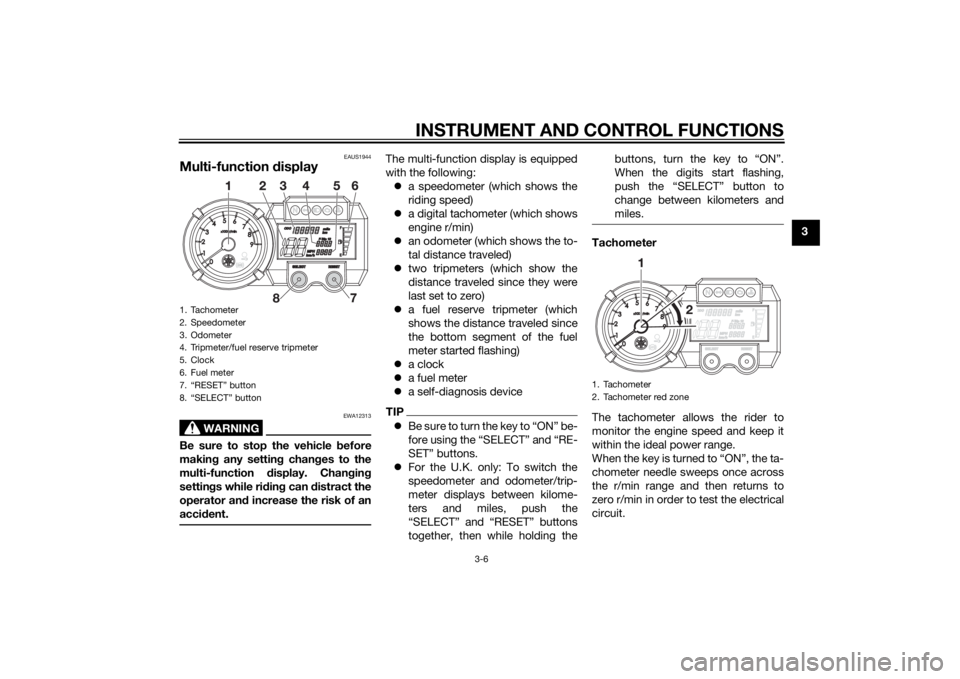
INSTRUMENT AND CONTROL FUNCTIONS
3-6
3
EAUS1944
Multi-function display
WARNING
EWA12313
Be sure to stop the vehicle before
making any setting changes to the
multi-function display. Changing
settings while riding can distract the
operator and increase the risk of an
accident.
The multi-function display is equipped
with the following:
a speedometer (which shows the
riding speed)
a digital tachometer (which shows
engine r/min)
an odometer (which shows the to-
tal distance traveled)
two tripmeters (which show the
distance traveled since they were
last set to zero)
a fuel reserve tripmeter (which
shows the distance traveled since
the bottom segment of the fuel
meter started flashing)
a clock
a fuel meter
a self-diagnosis deviceTIPBe sure to turn the key to “ON” be-
fore using the “SELECT” and “RE-
SET” buttons.
For the U.K. only: To switch the
speedometer and odometer/trip-
meter displays between kilome-
ters and miles, push the
“SELECT” and “RESET” buttons
together, then while holding thebuttons, turn the key to “ON”.
When the digits start flashing,
push the “SELECT” button to
change between kilometers and
miles.
Tachometer
The tachometer allows the rider to
monitor the engine speed and keep it
within the ideal power range.
When the key is turned to “ON”, the ta-
chometer needle sweeps once across
the r/min range and then returns to
zero r/min in order to test the electrical
circuit.
1. Tachometer
2. Speedometer
3. Odometer
4. Tripmeter/fuel reserve tripmeter
5. Clock
6. Fuel meter
7. “RESET” button
8. “SELECT” button
1. Tachometer
2. Tachometer red zone
U2BDE1E0.book Page 6 Tuesday, December 16, 2014 5:38 PM
Page 24 of 98
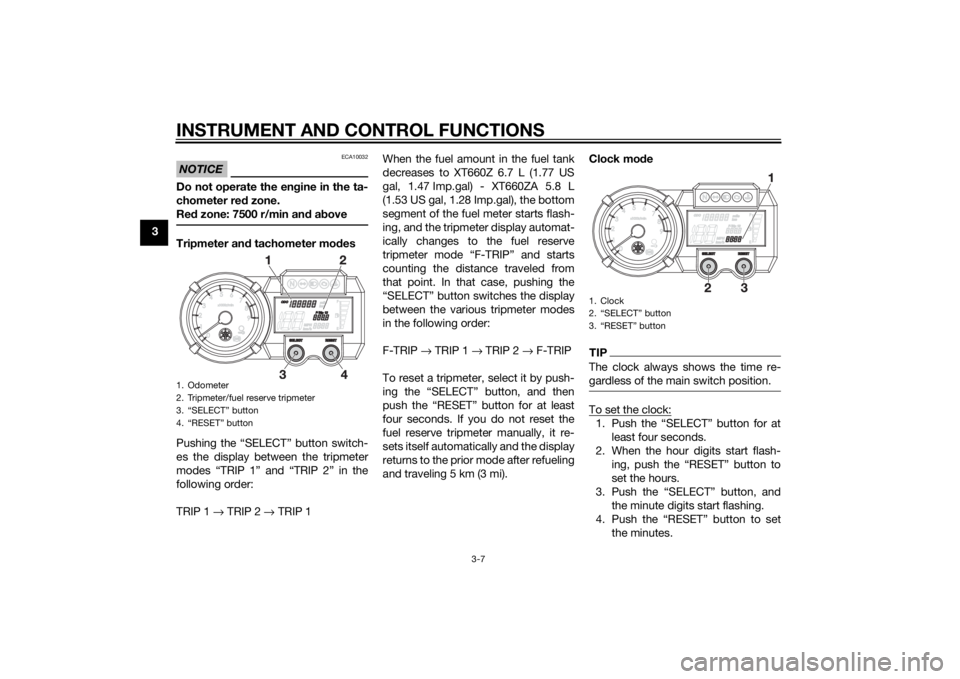
INSTRUMENT AND CONTROL FUNCTIONS
3-7
3
NOTICE
ECA10032
Do not operate the engine in the ta-
chometer red zone.
Red zone: 7500 r/min and aboveTripmeter and tachometer modes
Pushing the “SELECT” button switch-
es the display between the tripmeter
modes “TRIP 1” and “TRIP 2” in the
following order:
TRIP 1 → TRIP 2 → TRIP 1When the fuel amount in the fuel tank
decreases to XT660Z 6.7 L (1.77 US
gal, 1.47 Imp.gal) - XT660ZA 5.8 L
(1.53 US gal, 1.28 Imp.gal), the bottom
segment of the fuel meter starts flash-
ing, and the tripmeter display automat-
ically changes to the fuel reserve
tripmeter mode “F-TRIP” and starts
counting the distance traveled from
that point. In that case, pushing the
“SELECT” button switches the display
between the various tripmeter modes
in the following order:
F-TRIP → TRIP 1 → TRIP 2 → F-TRIP
To reset a tripmeter, select it by push-
ing the “SELECT” button, and then
push the “RESET” button for at least
four seconds. If you do not reset the
fuel reserve tripmeter manually, it re-
sets itself automatically and the display
returns to the prior mode after refueling
and traveling 5 km (3 mi).Clock mode
TIPThe clock always shows the time re-
gardless of the main switch position.To set the clock:1. Push the “SELECT” button for at
least four seconds.
2. When the hour digits start flash-
ing, push the “RESET” button to
set the hours.
3. Push the “SELECT” button, and
the minute digits start flashing.
4. Push the “RESET” button to set
the minutes.
1. Odometer
2. Tripmeter/fuel reserve tripmeter
3. “SELECT” button
4. “RESET” button
1. Clock
2. “SELECT” button
3. “RESET” button
U2BDE1E0.book Page 7 Tuesday, December 16, 2014 5:38 PM
Page 25 of 98
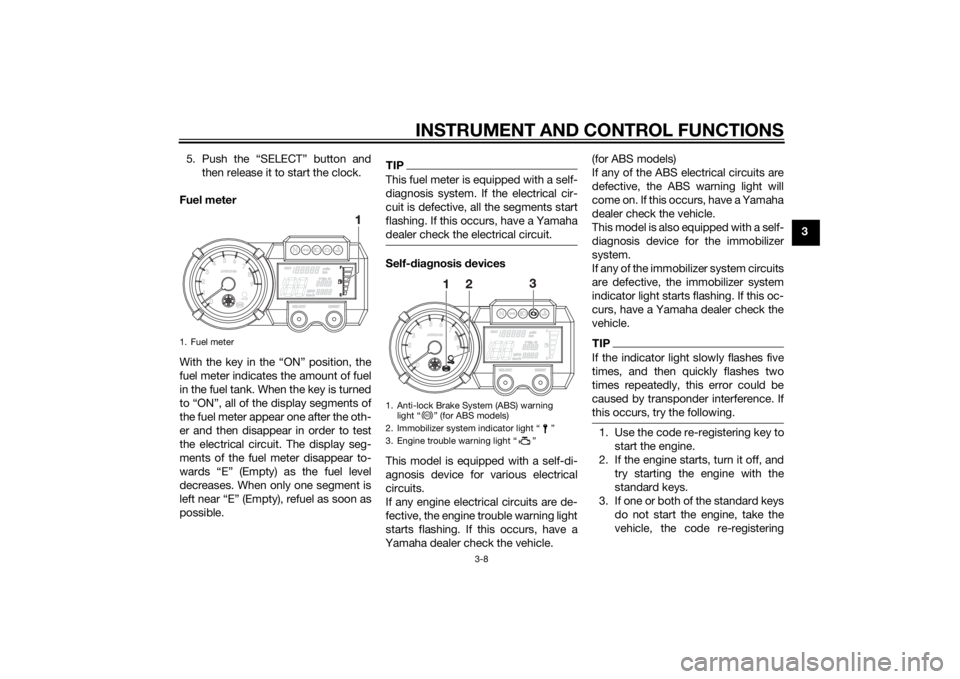
INSTRUMENT AND CONTROL FUNCTIONS
3-8
3 5. Push the “SELECT” button and
then release it to start the clock.
Fuel meter
With the key in the “ON” position, the
fuel meter indicates the amount of fuel
in the fuel tank. When the key is turned
to “ON”, all of the display segments of
the fuel meter appear one after the oth-
er and then disappear in order to test
the electrical circuit. The display seg-
ments of the fuel meter disappear to-
wards “E” (Empty) as the fuel level
decreases. When only one segment is
left near “E” (Empty), refuel as soon as
possible.
TIPThis fuel meter is equipped with a self-
diagnosis system. If the electrical cir-
cuit is defective, all the segments start
flashing. If this occurs, have a Yamaha
dealer check the electrical circuit.Self-diagnosis devices
This model is equipped with a self-di-
agnosis device for various electrical
circuits.
If any engine electrical circuits are de-
fective, the engine trouble warning light
starts flashing. If this occurs, have a
Yamaha dealer check the vehicle.(for ABS models)
If any of the ABS electrical circuits are
defective, the ABS warning light will
come on. If this occurs, have a Yamaha
dealer check the vehicle.
This model is also equipped with a self-
diagnosis device for the immobilizer
system.
If any of the immobilizer system circuits
are defective, the immobilizer system
indicator light starts flashing. If this oc-
curs, have a Yamaha dealer check the
vehicle.
TIPIf the indicator light slowly flashes five
times, and then quickly flashes two
times repeatedly, this error could be
caused by transponder interference. If
this occurs, try the following.1. Use the code re-registering key to
start the engine.
2. If the engine starts, turn it off, and
try starting the engine with the
standard keys.
3. If one or both of the standard keys
do not start the engine, take the
vehicle, the code re-registering
1. Fuel meter
1. Anti-lock Brake System (ABS) warning
light Ž (for ABS models)
2. Immobilizer system indicator light Ž
3. Engine trouble warning light Ž
ABS
U2BDE1E0.book Page 8 Tuesday, December 16, 2014 5:38 PM
Page 26 of 98
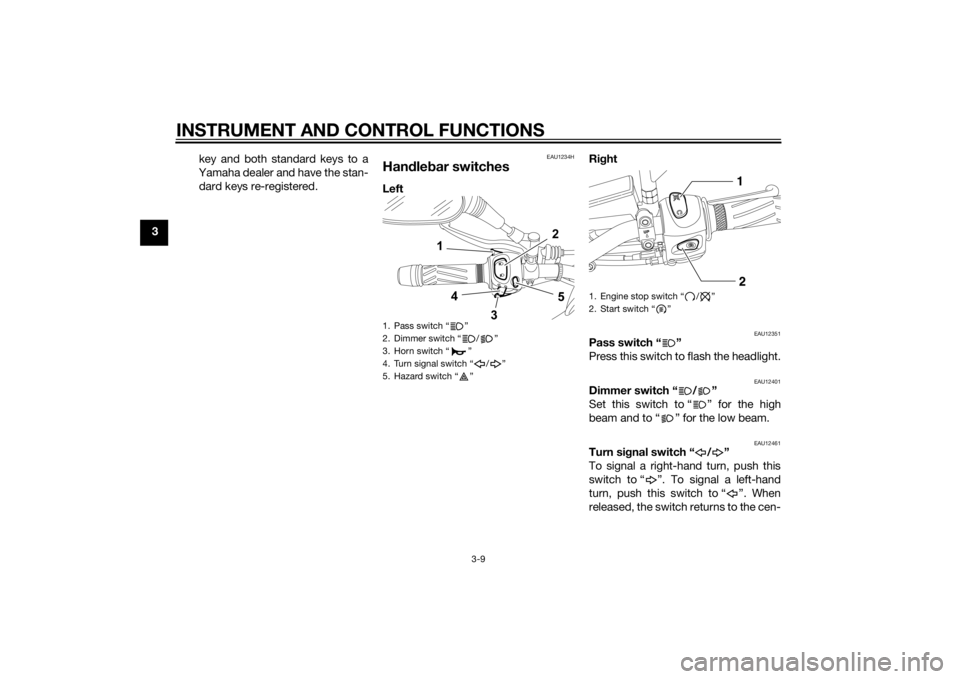
INSTRUMENT AND CONTROL FUNCTIONS
3-9
3key and both standard keys to a
Yamaha dealer and have the stan-
dard keys re-registered.
EAU1234H
Handlebar switchesLeftRight
EAU12351
Pass switch “ ”
Press this switch to flash the headlight.
EAU12401
Dimmer switch “ / ”
Set this switch to “ ” for the high
beam and to “ ” for the low beam.
EAU12461
Turn signal switch “ / ”
To signal a right-hand turn, push this
switch to “ ”. To signal a left-hand
turn, push this switch to “ ”. When
released, the switch returns to the cen-
1. Pass switch “ ”
2. Dimmer switch “ / ”
3. Horn switch “ ”
4. Turn signal switch “ / ”
5. Hazard switch “ ”
1. Engine stop switch “ / ”
2. Start switch “ ”
U2BDE1E0.book Page 9 Tuesday, December 16, 2014 5:38 PM
Page 27 of 98
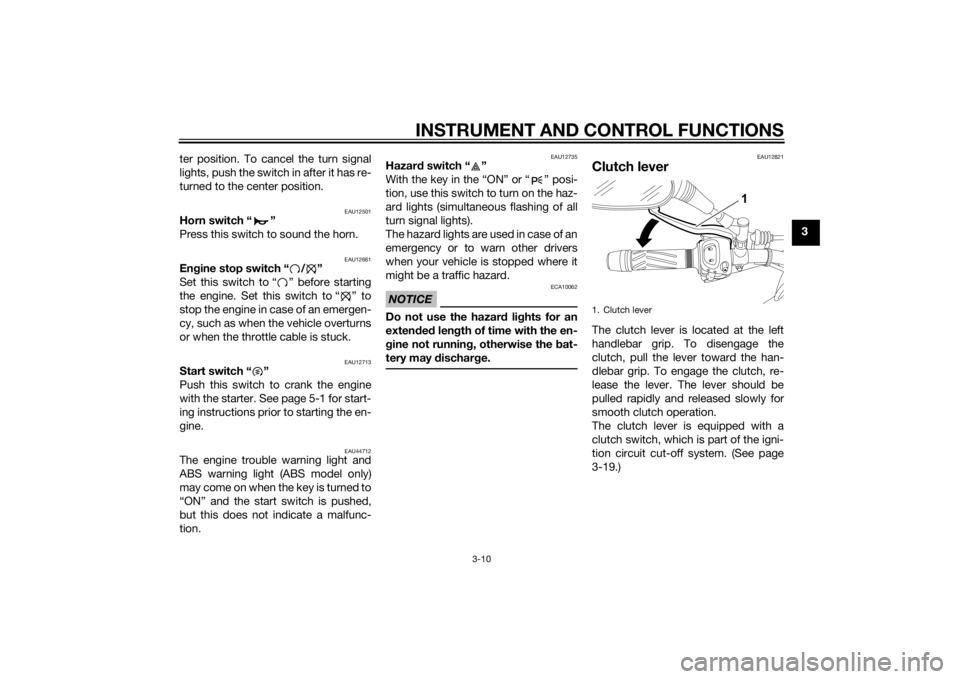
INSTRUMENT AND CONTROL FUNCTIONS
3-10
3 ter position. To cancel the turn signal
lights, push the switch in after it has re-
turned to the center position.
EAU12501
Horn switch “ ”
Press this switch to sound the horn.
EAU12661
Engine stop switch “ / ”
Set this switch to “ ” before starting
the engine. Set this switch to “ ” to
stop the engine in case of an emergen-
cy, such as when the vehicle overturns
or when the throttle cable is stuck.
EAU12713
Start switch “ ”
Push this switch to crank the engine
with the starter. See page 5-1 for start-
ing instructions prior to starting the en-
gine.
EAU44712
The engine trouble warning light and
ABS warning light (ABS model only)
may come on when the key is turned to
“ON” and the start switch is pushed,
but this does not indicate a malfunc-
tion.
EAU12735
Hazard switch “ ”
With the key in the “ON” or “ ” posi-
tion, use this switch to turn on the haz-
ard lights (simultaneous flashing of all
turn signal lights).
The hazard lights are used in case of an
emergency or to warn other drivers
when your vehicle is stopped where it
might be a traffic hazard.NOTICE
ECA10062
Do not use the hazard lights for an
extended length of time with the en-
gine not running, otherwise the bat-
tery may discharge.
EAU12821
Clutch leverThe clutch lever is located at the left
handlebar grip. To disengage the
clutch, pull the lever toward the han-
dlebar grip. To engage the clutch, re-
lease the lever. The lever should be
pulled rapidly and released slowly for
smooth clutch operation.
The clutch lever is equipped with a
clutch switch, which is part of the igni-
tion circuit cut-off system. (See page
3-19.)1. Clutch lever
U2BDE1E0.book Page 10 Tuesday, December 16, 2014 5:38 PM
Page 28 of 98
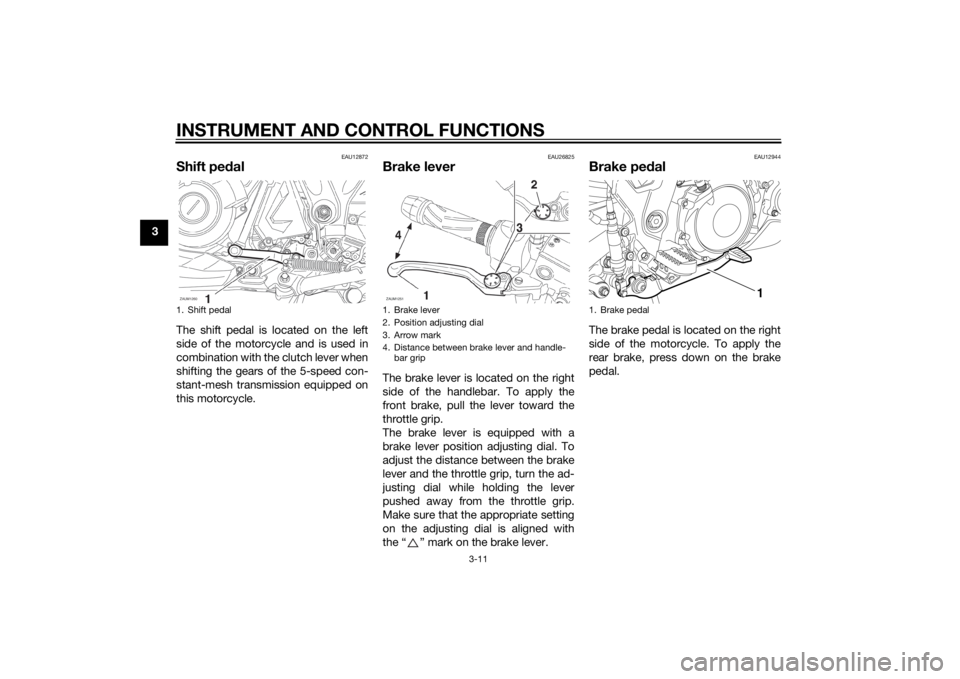
INSTRUMENT AND CONTROL FUNCTIONS
3-11
3
EAU12872
Shift pedalThe shift pedal is located on the left
side of the motorcycle and is used in
combination with the clutch lever when
shifting the gears of the 5-speed con-
stant-mesh transmission equipped on
this motorcycle.
EAU26825
Brake leverThe brake lever is located on the right
side of the handlebar. To apply the
front brake, pull the lever toward the
throttle grip.
The brake lever is equipped with a
brake lever position adjusting dial. To
adjust the distance between the brake
lever and the throttle grip, turn the ad-
justing dial while holding the lever
pushed away from the throttle grip.
Make sure that the appropriate setting
on the adjusting dial is aligned with
the “ ” mark on the brake lever.
EAU12944
Brake pedalThe brake pedal is located on the right
side of the motorcycle. To apply the
rear brake, press down on the brake
pedal.
1. Shift pedalZAUM1260
1. Brake lever
2. Position adjusting dial
3. Arrow mark
4. Distance between brake lever and handle-
bar grip
11
1
ZAUM1251
1. Brake pedal
U2BDE1E0.book Page 11 Tuesday, December 16, 2014 5:38 PM
Page 29 of 98
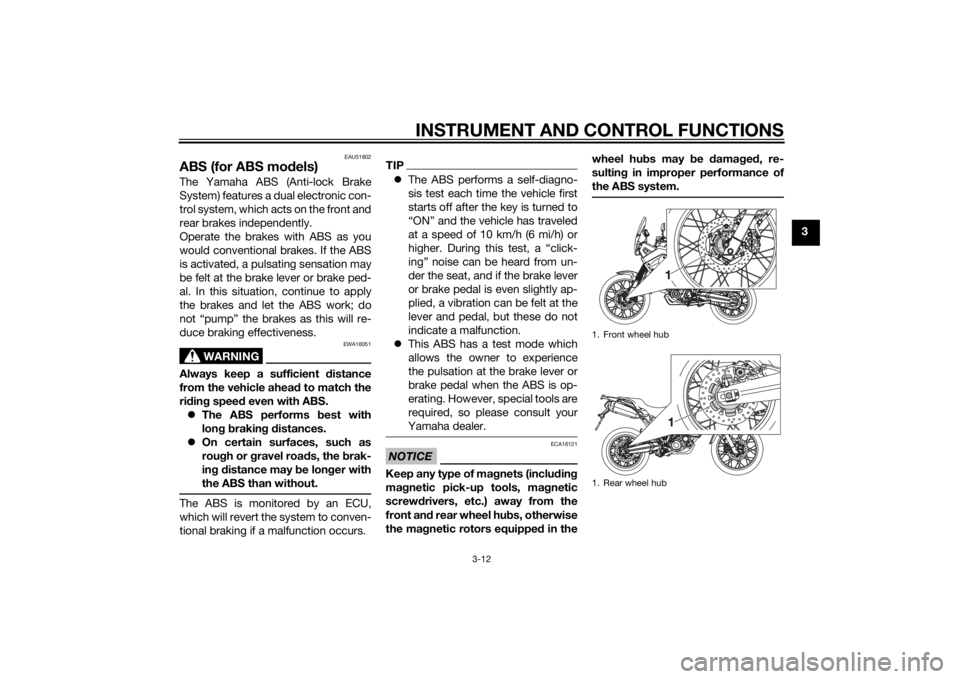
INSTRUMENT AND CONTROL FUNCTIONS
3-12
3
EAU51802
ABS (for ABS models)The Yamaha ABS (Anti-lock Brake
System) features a dual electronic con-
trol system, which acts on the front and
rear brakes independently.
Operate the brakes with ABS as you
would conventional brakes. If the ABS
is activated, a pulsating sensation may
be felt at the brake lever or brake ped-
al. In this situation, continue to apply
the brakes and let the ABS work; do
not “pump” the brakes as this will re-
duce braking effectiveness.
WARNING
EWA16051
Always keep a sufficient distance
from the vehicle ahead to match the
riding speed even with ABS.
The ABS performs best with
long braking distances.
On certain surfaces, such as
rough or gravel roads, the brak-
ing distance may be longer with
the ABS than without.The ABS is monitored by an ECU,
which will revert the system to conven-
tional braking if a malfunction occurs.
TIPThe ABS performs a self-diagno-
sis test each time the vehicle first
starts off after the key is turned to
“ON” and the vehicle has traveled
at a speed of 10 km/h (6 mi/h) or
higher. During this test, a “click-
ing” noise can be heard from un-
der the seat, and if the brake lever
or brake pedal is even slightly ap-
plied, a vibration can be felt at the
lever and pedal, but these do not
indicate a malfunction.
This ABS has a test mode which
allows the owner to experience
the pulsation at the brake lever or
brake pedal when the ABS is op-
erating. However, special tools are
required, so please consult your
Yamaha dealer.NOTICE
ECA16121
Keep any type of magnets (including
magnetic pick-up tools, magnetic
screwdrivers, etc.) away from the
front and rear wheel hubs, otherwise
the magnetic rotors equipped in thewheel hubs may be damaged, re-
sulting in improper performance of
the ABS system.
1. Front wheel hub
1. Rear wheel hub
U2BDE1E0.book Page 12 Tuesday, December 16, 2014 5:38 PM
Page 30 of 98
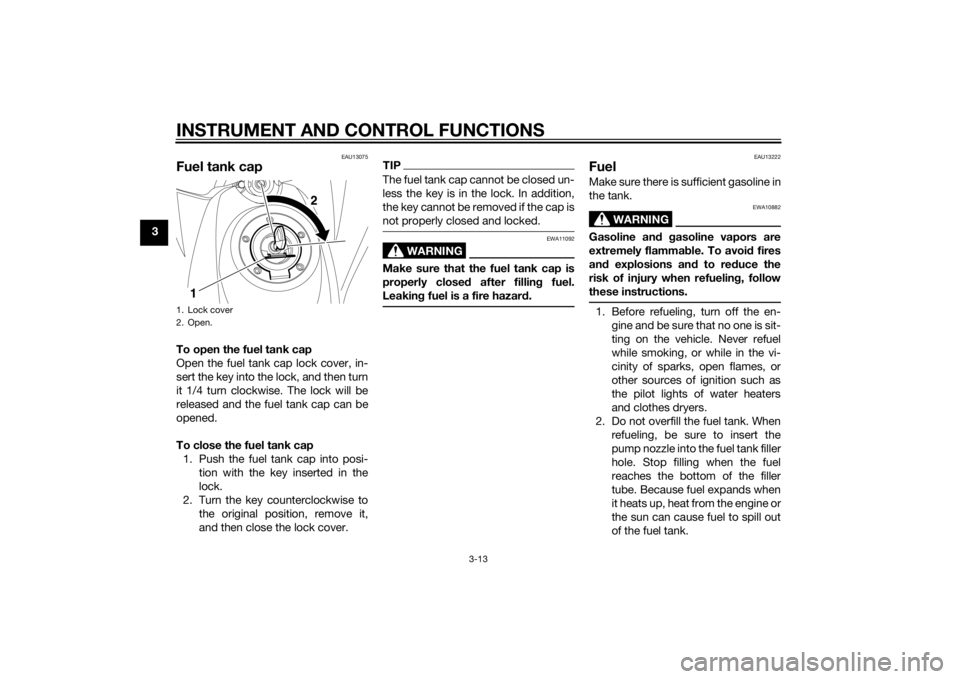
INSTRUMENT AND CONTROL FUNCTIONS
3-13
3
EAU13075
Fuel tank capTo open the fuel tank cap
Open the fuel tank cap lock cover, in-
sert the key into the lock, and then turn
it 1/4 turn clockwise. The lock will be
released and the fuel tank cap can be
opened.
To close the fuel tank cap
1. Push the fuel tank cap into posi-
tion with the key inserted in the
lock.
2. Turn the key counterclockwise to
the original position, remove it,
and then close the lock cover.
TIPThe fuel tank cap cannot be closed un-
less the key is in the lock. In addition,
the key cannot be removed if the cap is
not properly closed and locked.
WARNING
EWA11092
Make sure that the fuel tank cap is
properly closed after filling fuel.
Leaking fuel is a fire hazard.
EAU13222
FuelMake sure there is sufficient gasoline in
the tank.
WARNING
EWA10882
Gasoline and gasoline vapors are
extremely flammable. To avoid fires
and explosions and to reduce the
risk of injury when refueling, follow
these instructions.1. Before refueling, turn off the en-
gine and be sure that no one is sit-
ting on the vehicle. Never refuel
while smoking, or while in the vi-
cinity of sparks, open flames, or
other sources of ignition such as
the pilot lights of water heaters
and clothes dryers.
2. Do not overfill the fuel tank. When
refueling, be sure to insert the
pump nozzle into the fuel tank filler
hole. Stop filling when the fuel
reaches the bottom of the filler
tube. Because fuel expands when
it heats up, heat from the engine or
the sun can cause fuel to spill out
of the fuel tank.
1. Lock cover
2. Open.U2BDE1E0.book Page 13 Tuesday, December 16, 2014 5:38 PM